
April 1, 2025

December 2015 | Vol. XIV - No. 12
Barnes & Noble – will they learn the Sears lesson?
Barnes & Noble is the only remaining brick-and-mortar mass retailer of books and the company has had a very tough time. Their main business is books sold in their retail stores throughout the United States and they are battling technological change in the form of eBooks – downloaded to such gizmos as the IPad, Amazon’s Kindle and their own Nook. The trend line is very clear – eBooks are winning.
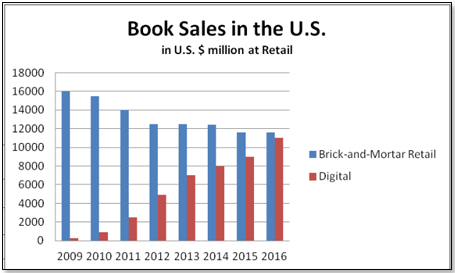
Source: Klosters Retailer Panel
It is not that Barnes & Noble did not try. They hitched their wagon to their own eBook device, the Nook, and devoted an inordinate amount of money and executive time to make it a success. They never got there – Amazon’s Kindle was in their way – and the end effect was that the Nook never took off and that their brick-and-mortar sales took a hammering. Their sales history tells it all:
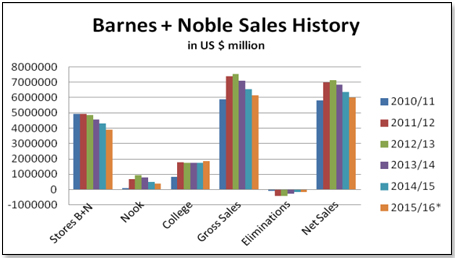
Source: SEC Filings *projected
Management finally decided that they had too much on their plate and elected to spin off their one reasonably successful endeavor, college bookstores. Barnes & Noble Education, Inc. went public at the beginning of August this year but continues to be mainly owned by Barnes & Noble Inc. This new company retails educational content and tools focused on college students and faculty in the United States via its 736 stores. It also markets Yuzu, a digital education platform, which enhances the teaching and learning experience. Their sales numbers are still included for comparison purposes in the Barnes & Noble Sales History chart above.
Barnes & Noble Inc. is now concentrating on three endeavors. One is the continued effort for Nook, the second their toy department and the third their core biz – the selling of books.
As far as the Nook is concerned, sales continue to fall off a cliff and there is no reason to assume that this will change in the near future. Amazon is just doing too good a job with its Kindle. The Nook continues to use excessive floor space and drains management time and effort without any visible results. My friends at B&N believe that management would divest the gizmo in a shot if a willing buyer came around. If that does not happen – and it is not something I would recommend to anybody given the dismal state of the product and its competitive state – the only alternative seems to be to just shut the whole thing down. If they do not do one or the other, the Nook could eventually represent an existential threat to the entire company.
Secondly Toys. They are doing a very good job there and are gaining market share as per the chart below.
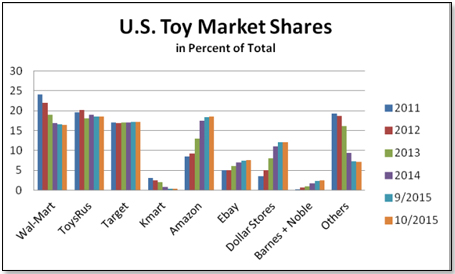
Source: Klosters Retailer Panel
They are engaged both in toys and collectibles and tend to be more educationally oriented than most other mass retailers. They are also pretty up to date in their assortment and have most of the best selling new products on their shelves. The products are well presented in welcoming surroundings and the staff on duty tends to be knowledgeable and helpful.
Finally, their core business is the selling of books via their 648 brick-and-mortar stores. There are a few oddities surrounding this business.
Firstly, if you go to the first chart – Book Sales in the U.S. – you will notice that the curve for Brick-and-Mortar sales of books, while still declining, has flattened out and is in fact expected to start growing again albeit modestly so.
Also, if you look at the consumer interest levels as epitomized by social media traffic, you will find that print books are doing pretty well compared to digital books as per Tickertags.com:

You would imagine that Barnes & Noble as the leading printed book purveyor should be performing in line with both curves but more likely should in fact be growing by increasing its market share. However, this is not happening. Their store sales, which are mainly books, are going South. My contacts at the company tell me that they are clearly losing market share to Amazon’s printed book business.The question is why – is it the stores, is it assortment or is it pricing?
Their stores are in good shape and the combination of having a place where you can sit and read a host of magazines while you drink your cup of java in the coffeeshop section is excellent. Nobody has the like.
To answer this question about assortment and price, I compared their top ten bestsellers versus Amazon. Amazon carried all ten and was 3.9% cheaper. I then compared Amazon’s top ten bestsellers versus Barnes & Noble’s. B&N carried all ten but was 2.3% more expensive. In other words, Barnes & Noble was equal to Amazon in assortment and reasonably competitive in price.
Consequently, their main business is suffering not because of lousy stores or dropping demand or declining consumer interest or core competitive factors. The answer to this question is in a totally different sphere of their business.
To demonstrate what this is, we should have a look at their Mission Statement on their website – Their Top 10 Reasons to Shop BN:
We’re No. 1 — in Customer Satisfaction
Barnes & Noble.com has repeatedly ranked No. 1 in customer satisfaction*.
*Number one rating in customer satisfaction in the entire e-commerce category of 200 companies, according to the 2007 American Customer Satisfaction Index of the University of Michigan. Ranked as top bookseller brand 5 consecutive years in the EquiTrend® Brand Study by Harris Interactive.
This may have been the case then but it is not the case today. The Temkin Group – a well-established research firm whose clients include such worthies as AIG, Dell, Fidelity Investments, McKesson and others – have just published the Retailer Table shown below which measured consumer satisfaction rankings in 2015. According to this, Barnes & Noble ranks is #41 and is tied with Dollar General and Sam’s Club. In comparison, Amazon is #4. Worse than that, Barnes & Noble’s position deteriorated versus 2014 whereas Amazon’s improved:
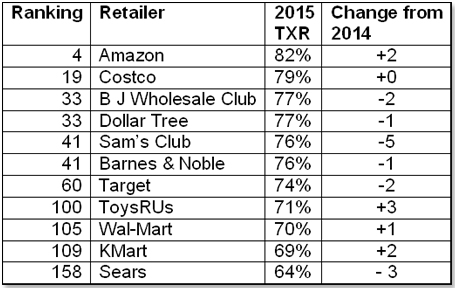
You could argue that this is a function of staff reductions on the store level undertaken as part of their cost reduction program. I do not believe that this is the case. Their shopfloor people are friendly, competent and helpful. However, the Consumeraffairs.com website has a very impressive listing of consumer complaints that cover the entire gamut of Barnes & Noble’s business activities. My friends at the company, particularly those that work on the shopfloor, confirm that consumer complaints about backoffice service are vocal, frequent and increasing.
Just to make sure, I conducted a small test of my own. I sent a very friendly and respectful email to the appropriate senior Barnes & Noble executive, introduced myself as a writer in the toy space with a monthly column in two highly regarded industry publications, and asked for the opportunity to speak to somebody within Barnes & Noble about their business as I was in the process of writing an article about the company and wished to present a balanced picture. This email was sent on October 20. Since I did not receive an acknowledgment, let alone a reply, I sent the following email to the same person on November 2:
"Good evening XXXX [name withheld],
I sent you an email nearly two weeks ago mentioning that I was planning to write an article on Barnes + Noble's toy biz and asking you to facilitate a conversation between me and any B+N executive in a position to provide your company's side to it . Since I have not heard from you I assume that you are not willing to do so but I would have appreciated the courtesy of a reply anyway. I will of course proceed with this article in any event and will reach out to friends I have within B+N and its competitors to get a balanced view on a number of issues. I will also in this article quote this email in its totality.
Kind regards,
Lutz"
Until today, two weeks later, there was no reply to this second email either.
I have found over decades of working with retailers on five Continents that there is a clear correlation between consumer satisfaction on one side and the longer term success or failure of the retailer on the other. On a more scientific level, the Gotland University, Visby, Sweden, carried out a study entitled "Customer Satisfaction towards Retailers" in Spring 2011. This study says that:
"Some researchers assert that satisfaction is most likely to influence repurchase intention through positive word of mouth whereas dissatisfaction encourages negative word of mouth and serves as reason for discontinuation of purchase and customer defection. Satisfied customers are likely to recommend to five or six people while dissatisfied ones have tendency to share their experiences to other ten people (Hoyer & MacInns 2001; La Barbera & Mazursky 1983). Similarly, Anton (1996) cited in Singh (2006) asserts that, satisfaction is positively associated with repurchase intentions which is linked to increasing ones likelihood of recommending a product or service, loyalty and profitability". Aaker (1995) suggests that one of the strategic aspects for organizational success is through customer satisfaction and loyalty. Customer satisfaction once achieved leads to loyalty and retention of customers".
Barnes & Noble has now two top executives who should know all about consumer dissatisfaction. Michael P Husby, their Group CEO, and Ronald D Boire, very recently appointed CEO of the Barnes & Noble Retail Division, both came from Sears/Kmart. Sears’ customer satisfaction index in 2013 and 2014, when both executives were in key positions there, was very poor. In these two years, Sears compared to Amazon and Barnes & Noble as per the ACSI [American Customer Satisfaction Index] as follows:
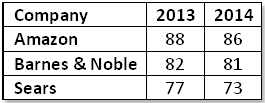
In all fairness, it has to be said that both executives were really in no position to do much about this totally unacceptable consumer satisfaction status.Firstly, the company was and is totally micromanaged by Edward Lampert, Chairman and major shareholder of Sears. Secondly, the entire management effort at Sears was then and is now completely focused on cutting expenses and consumer satisfaction levels were and are probably the least of management’s headaches. However, I would think that both executives – being the extremely competent and intelligent businessmen they are – knew that the fate of Sears was in fact inextricably linked to the approval level of its consumers and that this was perhaps one of the reasons why they decided to leave the company. If that is the case, then they are now in a position to put this knowledge to work at Barnes & Noble.
Finally, I would argue two points. One is that Barnes & Noble’s troubles are self-inflicted. The second is that a remedy is very difficult because it would entail changing the company’s culture from top to bottom. Difficult? Yes. Impossible? No!
Copyright © 2025 TDmonthly®, a division of TOYDIRECTORY.com®,
Inc.








